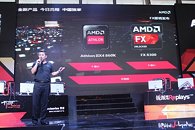- Joined
- Oct 9, 2007
- Messages
- 47,847 (7.39/day)
- Location
- Dublin, Ireland
| System Name | RBMK-1000 |
|---|---|
| Processor | AMD Ryzen 7 5700G |
| Motherboard | Gigabyte B550 AORUS Elite V2 |
| Cooling | DeepCool Gammax L240 V2 |
| Memory | 2x 16GB DDR4-3200 |
| Video Card(s) | Galax RTX 4070 Ti EX |
| Storage | Samsung 990 1TB |
| Display(s) | BenQ 1440p 60 Hz 27-inch |
| Case | Corsair Carbide 100R |
| Audio Device(s) | ASUS SupremeFX S1220A |
| Power Supply | Cooler Master MWE Gold 650W |
| Mouse | ASUS ROG Strix Impact |
| Keyboard | Gamdias Hermes E2 |
| Software | Windows 11 Pro |
In addition to its new A-series APUs, AMD announced two new CPUs, the Athlon 860K, and the FX-8300. Built in the FM2+ package, the Athlon 860K is a quad-core CPU based on the 28 nm "Kaveri" silicon, with its integrated graphics disabled. It features four "Steamroller" CPU cores clocked at 3.70 GHz, with an unlocked base-clock multiplier that enables overclocking. The two modules that make up the four cores feature half their normal L2 cache amounts, and so the total L2 cache is just 2 MB. The chip will run on socket FM2+ motherboards based on the A88X, A85, A75, and A55 chipsets. The FX-8300, on the other hand, is a budget eight-core processor in the AM3+ package. It's based on the 32 nm "Vishera" silicon, featuring eight CPU cores spread across four "Piledriver" modules; clocked at 3.20 GHz, with 3.50 GHz of Turbo Core frequencies. The chips feature 2 MB of L2 cache per module, and 8 MB of shared L3 cache. Its TDP is rated at 95W.

View at TechPowerUp Main Site

View at TechPowerUp Main Site


 For a moment I thought they had announced an 8 core FM2+ CPU
For a moment I thought they had announced an 8 core FM2+ CPU 


